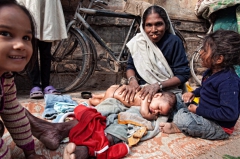02/16/2015
Babies made-in-India - 8. Massage, bath & Breastfeeding
 Once back home, almost everywhere in India, professionals called maalishwali come home to give massage and bath to mothers and infants.
Once back home, almost everywhere in India, professionals called maalishwali come home to give massage and bath to mothers and infants.
And this technique is somehow spreading in the West, with an interesting twist: the parents massage the baby themselves. It is a good to create a bond, while developing the motor skills of the child. The problem with this ‘twist’ is that the mother rarely gets her massage, unless the father is really available (and talented)! Be careful in cold western environment though ;)
For the mother, the idea is that massaging helps the inside organs to get back in place and shape. Paradoxically the re-education of the perineum is not even addressed by the Gynec! Finally, when I asked her,she told me to do some Kegel exercises at home. (I must add that my British midwife has also never heard of the type of perineum re-education prescribed by doctors and performed by physiotherapists in France.)
For the baby's bath, the masseuse sits on the floor with her leg stretched on which the infant lies. Less water wastage, less dangerous than a bucket which can fall of the table and from which the infant can swallow water (especially when he is slippery after a good massage!) but also less fun than a bathtub where he can turn and splash!
As for breastfeeding, beware! You shouldn’t say you are thinking it over! Indians can not understand, for example, that only 56% of French mothers or 69% of British ones breastfeed.
So even if the World Health Organization and UNICEF recommend to “initiate breastfeeding within one hour following birth; practice exclusive breastfeeding during the first six months; and continue breastfeeding for two years and beyond, while starting from the age of six months a supplementary feeding [...]”, it always sound weird to hear a woman say that she is breastfeeding her 4 year old...And it is not uncommon here...
And now, I am done! Be happy that I have spoken only about the most widespread traditions! And not of the custom of eating the placenta for its hormones (which would be better assimilated if the placenta was consumed raw) and to reduce stress. Or of mothers giving girls “joyous genital tickling” and boys “full-on fellatio” (which for these people is not a sexual practice whereas kissing, even the cheek is…). I must say that these traditions are actually mostly Chinese but still present in some parts of India!
Sources: http://www.lllfrance.org/Autres-textes-LLL/Epidemiologie-de-l-allaitement-Allaitement-et-contraception.html ; http://www.unicef.org/french/nutrition/index_24824.html; http://listverse.com/2014/05/03/10-weirdest-birth-customs-from-around-the-world/
(The End)
08:00 Posted in Expatriation (in India and in other countries), Incredible India!, Little Samourai, My stories in India | Permalink | Comments (0) | Tags: india, birth, water birth, pregnancy, baby, infant, newborn, delivery, midwife, swaddling, swaddle, diaper, breastfeeding, hospital, fertility, contraception, sterilization | ![]() Facebook | |
Facebook | |
02/14/2015
Babies made-in-India - 7. The swaddle and the diaper
 Another tradition going on strong is swaddling infants. The benefits are the creation of a sense of security for the baby (it reminds him the uterus), and comfort as it helps him control the reflex-movements that can bother him. For the mother, it's more convenient to carry the kid, a small quiet package. As a result, in India, infants are swaddled most of the time up to three months. On top of above mentioned advantages, it is also believed that it will enable the legs to grow straight. And the hip problems that can be created are royally ignored.
Another tradition going on strong is swaddling infants. The benefits are the creation of a sense of security for the baby (it reminds him the uterus), and comfort as it helps him control the reflex-movements that can bother him. For the mother, it's more convenient to carry the kid, a small quiet package. As a result, in India, infants are swaddled most of the time up to three months. On top of above mentioned advantages, it is also believed that it will enable the legs to grow straight. And the hip problems that can be created are royally ignored.
Since swaddling can indeed be reassuring and appeasing for some infants, you can choose an intermediate solution, like swaddling the baby only during sleep time – it is also interesting to know that this practice after being out-of-fashion in the past decades in the West is now doing its come-back (6).
If you decide to leave the baby legs free when he is not sleeping, then you must be ready, when you enter a hotel carrying your newborn 'monkey-style' to face the outraged looks of doormen, or even their comments: "you should not wear him like that! Poor thing! His legs!!”. Or to bear with the salesguy of Benetton who is likely to get offended and say so out loud, repeatedly, because you should not use a carrier during the first six months...
 To get back to the topic of swaddling, I imagine that this practice goes hand in hand with the use of the Indian cotton nappy. Which is like a piece of cloth with a thread that you fill with other pieces of cloth. The advantages of this diaper is that it is softer for the
To get back to the topic of swaddling, I imagine that this practice goes hand in hand with the use of the Indian cotton nappy. Which is like a piece of cloth with a thread that you fill with other pieces of cloth. The advantages of this diaper is that it is softer for the  butt of the child, cheaper and more eco-friendly (but I am not so sure because you need to do a lot of washing), and the child gets potty-trained faster since he quickly gets tired of having his ass wet all the time. Well, I tried several times at the hospital but I can’t help it, I don’t understand how poop and pee don’t spread everywhere on the child and about everywhere else! Maybe it works better if the baby is kept tightly wrapped (hence moving less)?
butt of the child, cheaper and more eco-friendly (but I am not so sure because you need to do a lot of washing), and the child gets potty-trained faster since he quickly gets tired of having his ass wet all the time. Well, I tried several times at the hospital but I can’t help it, I don’t understand how poop and pee don’t spread everywhere on the child and about everywhere else! Maybe it works better if the baby is kept tightly wrapped (hence moving less)?
Anyway, the only cheap and eco-friendly solution is to leave the baby barebutt... A solution still preferred in the countryside where kids are left very early to deal with themselves or at the signal where babies make people feel bad and more inclined to depart with a coin (hence some business of baby trafficking, cf this post)...
(6) “Nine out of 10 infants in north America are now swaddled in the first six months of life. Sales of swaddling clothes increased in the UK by 61% between 2010 and 2011.” (Source: http://www.theguardian.com/society/2013/oct/28/swaddling-babies-blankets-hip-problems-doctors-warn)
(To be continued...)
08:00 Posted in Expatriation (in India and in other countries), Incredible India!, Little Samourai, My stories in India | Permalink | Comments (0) | Tags: india, birth, water birth, pregnancy, baby, infant, newborn, delivery, midwife, swaddling, swaddle, diaper, breastfeeding, hospital, fertility, contraception, sterilization | ![]() Facebook | |
Facebook | |
02/12/2015
Babies made-in-India - 6. Medicalization of birth
70% of Indian babies are born at home, with the help of a midwife (dai). Paradoxically, the 'modern' hospitals (which rank from very bad to at par (or even better) than Western infrastructures) do not recognize this profession! As a result, my (British) midwife was often denied access to the delivery room, or Gynec would refuse to team up with her (in any case, the Gynec would remain the boss and not consult her).
Indians tend to blindly trust doctors. Therefore, the practice of episiotomy (a preventive cut of the vagina), while in sharp decline in the West (5), remains widespread. Most mothers don’t even know that it is optional. Worse, most new mothers don’t even know it is going to happen to her! And they can’t be blamed: even my Gynec never mentioned episiotomy and it is thanks to my midwife that I got to know about it it...
Moreover, Indian women are not well aware of anesthesia during childbirth. To the point that I couldn’t find statistics, except a small survey which confirms my opinion. When I mentioned the epidural to friends and colleagues, they generally had never heard of it and were unable to understand how to deliver a baby without feeling contractions – a valid question I must say, that I could answer only after having my baby!
Nowadays nearly half of the deliveries in India are acts of surgery (compared to 21% in France, 25% in England)... And as much in the countryside as in the cities.
Even more striking is the increase in scheduled C-sections (vs. medically necessary ones). The culprits? A bit everyone. For doctors it is more profitable (they charge more for surgical procedures), easier to fit in the agenda and (some claim it) less risky for the patient. A for women, it is often reimbursed by private insurances, perceived as less painful, easier to fit in the agenda (especially when they have Astral imperatives and want the baby to be born with an auspicious star configuration (I am not kidding!)) and (some believe so) less risky.
(5) In France, "the episiotomy rate has decreased from 71 to 45% between 1998 and 2010”.
Sources: http://www.midwiferytoday.com/articles/india.asp ;http://www.liberation.fr/vous/2011/10/18/70-d-accouchements-avec-peridurale_768628 ; http://www.who.int/healthsystems/topics/financing/healthreport/30C-sectioncosts.pdf ; http://www.huffingtonpost.com/2014/04/16/c-section-rates_n_5161162.html?ir=India ; http://qz.com/326402/cesarean-births-in-india-are-skyrocketing-and-there-is-reason-to-be-very-worried/; http: / / www.cesarine.org/ front/etat_des_lieux.php . http://www.hscic.gov.uk/catalogue/PUB12744/nhs-mate-eng-2012-13-summ-repo-rep.pdf; http://www.Liberation.fr/vous/2011/10/18/70-d-accouchements-avec-peridurale_768628
(To be continued...)
08:00 Posted in Expatriation (in India and in other countries), Incredible India!, Little Samourai, My stories in India | Permalink | Comments (0) | ![]() Facebook | |
Facebook | |















